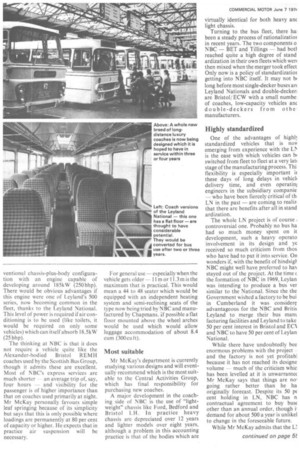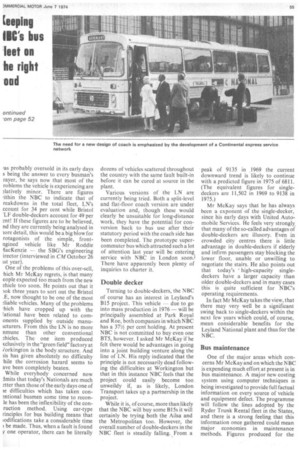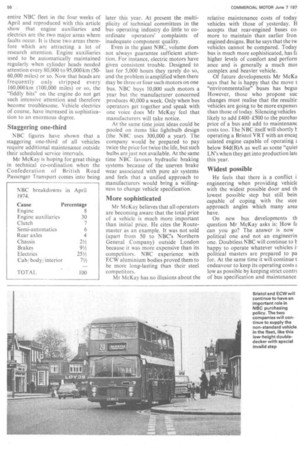low National Travel's new coach will look 0 The background
Page 53

Page 54

Page 57

Page 58

If you've noticed an error in this article please click here to report it so we can fix it.
to the eyland National project D What's what in double-deck bus design 0 Vhat causes bus breakdowns.
BC's engineering policy reviewed and explained by Makin Hayes
S BRITAIN's leading bus and coach nrator, the National Bus Company ields unrivalled influence on vehicle !sign and operating technology. Ideed, it has crossed the dividing line :tween operator and manufacturer ith its involvement in Leyland ational, Bristol, Eastern Coach 'orks, Park Royal and Charles Roe. n what policy objectives lie behind is influence? The answer to this lestion has a fundamental importice for all UK psv operators and to td out what it is I have just under taken an exclusive interview with Mr George McKay, NBC's director of technical services.
Based at New Street Square, London, Mr McKay has responsibility for technical innovation and buying policy throughout the NBC including both buses and coaches. It was on the latter subject that our conversation began.
It is no secret in the coach world that NBC is urgently examining the specification for a whole new breed of long-distance coaches. The problem is that National Travel requires a highly sophisticated vehicle of a type not currently available in Britain, but in relatively low numbers — probably not more than 100 a year, which is unlikely to attract potentially heavy investment by the coachbuilding industry. At present the National Travel coach fleet spends about two years on "top notch" services before being down-graded to other, less arduous duties. This is a factor which also has to be taken into account when specifying a new vehicle.
What NBC is considering, I can now reveal, is a high-floored coach of con ventional chassis-plus-body configuration with an engine capable of developing around 185kW (250 bhp). There would be obvious advantages if this engine were one of Leyland's 500 series, now becoming common in the fleet, thanks to the Leyland National. This level of power is required if air conditioning is to be used (like toilets, it would be required on only some vehicles) which can itself absorb 18.5k W (25 bhp).
The thinking at NBC is that it does not require a vehicle quite like the Alexander-bodied Bristol REM!-! coaches used by the Scottish Bus Group, though it admits these are excellent. Most of NBC's express services are much shorter an average trip of, say, four hours — and visibility for the passenger is of higher importance than that on coaches used primarily at night. Mr McKay personally favours simple leaf springing because of its simplicity but says that this is only possible where loadings are permanently at 80 per cent of capacity or higher. He expects that in practice air suspension will be necessary. For general use — especially when the vehicle gets older — II m or 11.3 m is the maximum that is practical. This would mean a 44 to 48 seater which would be equipped with an independent heating system and semi-reclining seats of the type now being tried by NBC and manufactured by Chapmans. if possible a flat floor mounted above the wheel arches would be used which would allow luggage accommodation of about 8.4 cum (300 cu ft).
Most suitable
Mr McKay's department is currently studying various designs and will eventually recommend which is the most suitable to the Central Activities Group, which has final responsibility for purchasing new coaches.
A major development in the coaching side of NBC is the use of "lightweight" chassis like Ford, Bedford and Bristol LH. In practice heavy chassis are depreciated over 12 years and lighter models over eight years, although a problem in this accounting practice is that of the bodies which are
virtually identical for both heavy anc light chassis.
Turning to the bus fleet, there ha: been a steady process of rationalizatiot in recent years. The two components o NBC — BET and Tillings — had bott reached quite a high degree of stand ardization in their own fleets which wen then mixed when the merger took effect Only now is a policy of standardizatiot getting into NBC itself. It may not 111 long before most single-decker buses an Leyland Nationals and double-decker: are Bristol/ ECW with a small numbe: of coaches, low-capacity vehicles anc double-deckers from °themanufacturers.
Highly standardized
One of the advantages of highl! standardized vehicles that is nov emerging from experience with the LTs is the ease with which vehicles can bi switched from fleet to fleet at a very lab stage of the manufacturing process. Thi flexibility is especially important it these days of long delays in vehicli delivery time, and even operatinl engineers in the subsidiary companie — who have been fiercely critical of th, LN in the past — are coming to realiz. that there are benefits after all in stand ardization.
The whole LN project is of course ; controversial one. Probably no bus ha had so much money spent on it development, such a heavy operato involvement in its design and ye received so much criticism from thos who have had to put it into service. On wonders if, with the benefit of hindsigt NBC might well have preferred to hal" stayed out of the project. At the time c the formation of NBC in 1969, Leylan was intending to produce a bus ver similar to the National. Since the the Government wished a factory to be bui in Cumberland it was considere advantageous for the NBC and Britis Leyland to merge their bus mant facturing facilities and Leyland to take 50 per cent interest in Bristol and ECN and NBC to have 50 per cent of Leylan National.
While there have undoubtedly bee enormous problems with the project and the factory. is not yet profitabl because it has not reached its designe volume — much of the criticism whic has been levelled at it is unwarrantec Mr McKay says that things are no, going rather better than he ha originally forecast. Despite its 50 pt cent holding in LN, NBC has n contractual agreement to buy bust other than an annual order, though ii demand for about 500 a year is unlike] to change in the foreseeable future.
While Mr McKay admits that the LI 'as probably oversold in its early days s being the answer to every busman's rayer, he says now that most of the roblems the vehicle is experiencing are :latively minor. There are figures /ithin the NBC to indicate that of reakdowns in the total fleet, LN's ccount for 34 per cent while Bristol IF double-deckers account for 49 per :nt! If these figures are to be believed, nd they are currently being analysed in lore detail, this would be a big blow for rotagonists of the simple, frontngined vehicle like Mr Roddie lacKenzie — the SBG's engineering irector (interviewed in CM October 26 ist year).
One of the problems of this over-sell, hich Mr McKay regrets, is that many eople expected too much from the new :hide too soon. He points out that it 10k three years to sort out the Bristol .E, now thought to be one of the most :liable vehicles. Many of the problems bich have cropped up with the rational have been related to comonents supplied by outside manuicturers. From this the LN is no more nmune than other conventional :hides. The one item produced xclusively in the "green field" factory at Jorkington is the body-structure. And us has given absolutely no difficulty bile the corrosion hazard seems to ave been completely beaten.
While everybody concerned now imits that today's Nationals are much :tter than those of the early days one of le difficulties which has taken con:ntional busmen some time to reconle has been the inflexibility of the conruction method. Using car-type rinciples for bus building means that lodifications take a considerable time be made. Thus, when a fault is found y one operator, there can be literally dozens of vehicles scattered throughout the country with the same fault built-in before it can be cured at source in the plant.
Various versions of the LN are currently being tried. Both a split-level and flat-floor coach version are under evaluation and, though these would clearly be unsuitable for long-distance work, they have the potential for conversion back to bus use after their statutory period with the coach side has been completed. The prototype supercommuter bus which attracted such a lot of attention last year will be entering service with NBC in London soon.1 There have apparently been plenty of inquiries to charter it.
Double decker
Turning to double-deckers, the NBC of course has an interest in Leyland's B15 project. This vehicle — due to go into mass production in 1976 — will be principally assembled at Park Royal and Roe, both companies in which NBC has a 371/2 per cent holding. At present NBC is not committed to buy evenone BT5, however. I asked Mr McKay if he felt there would be advantages in going into a joint building venture along the line of LN. His reply indicated that the principle is not necessarily dead following the difficulties at Workington but that in this instance NBC feels that the project could easily become too unweildy if, as is likely, London Transport takes up a partnership in the project.
While it is, of course, more than likely that the NBC will buy some BI5s it will certainly be trying both the Ailsa and the Metropolitan too. However, the overall number of double-deckers in the NBC fleet is steadily falling. From a peak of 9135 in 1969 the current downward trend is likely to continue with a predicted figure in 1975 of 6811. (The equivalent figures for singledeckers are 11,502 in 1969 to 9138 in 1975.) Mr McKay says that he has always been a exponent of the single-decker, since his early days with United Automobile Services. He feels very strongly. that many of the so-called advantages of double-deckers are illusory. Even in crowded city centres there is little advantage in double-deckers if elderly and infirm passengers stay blocking the lower floor, unable or unwilling to negotiate the stairs. He also points out that today's high-capacity singledeckers have a larger capacity than older double-deckers and in many cases this is quite sufficient for NBC's operating requirements.
In fact Mr McKay takes the view, that there may very well be a significant swing back to single-deckers within the next few years which could, of course, mean considerable benefits for the Leyland National plant and thus for the NBC.
Bus maintenance
One of the major areas which concerns Mr McKay and on which the NBC is expending much effort at present is in bus maintenance. A major new costing system using computer techniques is being investigated to provide full factual information on every source of vehicle and equipment defect. The programme will follow the lines adopted by the Ryder Trunk Rental fleet in the States, and there is a strong feeling that this information once gathered could mean major economies in maintenance methods. Figures produced for the entire NBC fleet in the four weeks of April and reproduced with this article show that engine auxiliaries and electrics are the two major areas where faults occur. It is these two areas therefore which are attracting a lot of research attention. Engine auxiliaries used to be automatically maintained regularly when cylinder heads needed attention every 80,000 to 95,000 km (5060,000 miles) or so. Now that heads are frequently only stripped every 160,000 km (100,000 miles) or so, the "fiddly bits" on the engine do not get such intensive attention and therefore become troublesome. Vehicle electrics of course, have increased in sophistication to an enormous degree.
Staggering one-third
NBC figures have shown that a staggering one-third of all vehicles require additional maintenance outside their scheduled service intervals.
Mr McKay is hoping for great things in technical co-ordination when the Confederation of British Road Passenger Transport comes into being later this year. At present the multiplicity of technical committees in the bus operating industry do little to coordinate operators' complaints of inadequate component quality.
Even in the giant NBC, volume does not always guarantee sufficient attention. For instance, electric motors have given consistent trouble. Designed to last for 5,000 hours they rarely do so, and the problem is amplified when there May be three or four such motors on one bus. NBC buys 10,000 such motors a year but the manufacturer concerned produces 40,000 a week. Only when bus operators get together and speak with one voice does Mr McKay feel that manufacturers will take notice.
At the same time joint ideas could be pooled on items like lightbulb design (the NBC uses 300,000 a year). The company would be prepared to pay twice the price for twice the life, but such bulbs are just not available. At the same time NBC favours hydraulic braking systems because of the uneven brake wear associated with pure air systems and feels that a unified approach to manufacturers would bring a willingness to change vehicle specification.
More sophisticated
Mr McKay believes that all operators are becoming aware that the total price of a vehicle is much rinore important than initial price. He cites the Routemaster as an example. It was not sold (apart from 50 to NBC's Northern General Company) outside London because it was more expensive than its competitors. NBC experience with ECW aluminium bodies proved them to be more long-lasting than their steel competitors.
Mr McKay has no illusions about the relative maintenance costs of today vehicles with those of yesterday. B accepts that rear-engined buses co: more to maintain than earlier fron engined designs. But he says that the tw vehicles cannot be compared. Today bus is much more sophisticated, has fE higher levels of comfort and perforn ance and is generally a much mot complex and heavier vehicle.
Of future developments Mr McKa says that he is happy that the move t "environmentalise" buses has begot However, those who propose suc changes must realise that the resultir, vehicles are going to be more expenm than those of today. Silencing vehicles likely to add £400—£500 to the purcha.5. price of a bus and add to maintenanc costs too. The NBC itself will shortly operating a Bristol VRT with an encay sulated engine capable of operating below 84d(B)A as well as some "quiet LN's when they get into production late this year.
Widest possible
He feels that there is a conflict i engineering when providing vehicle with the widest possible door and th lowest possible step but still bein capable of coping with the stee approach angles which many area have.
On new bus developments th question Mr McKay asks is: How fa can you go? The answer is now political one and not an engineerin one. Doubtless NBC will continue to happy to operate whatever vehicles ii political masters are prepared to pa for. At the same time it will continue t endeavour to keep its operating costs low as possible by keeping strict contr< of bus specification and maintenance.




























































































































































